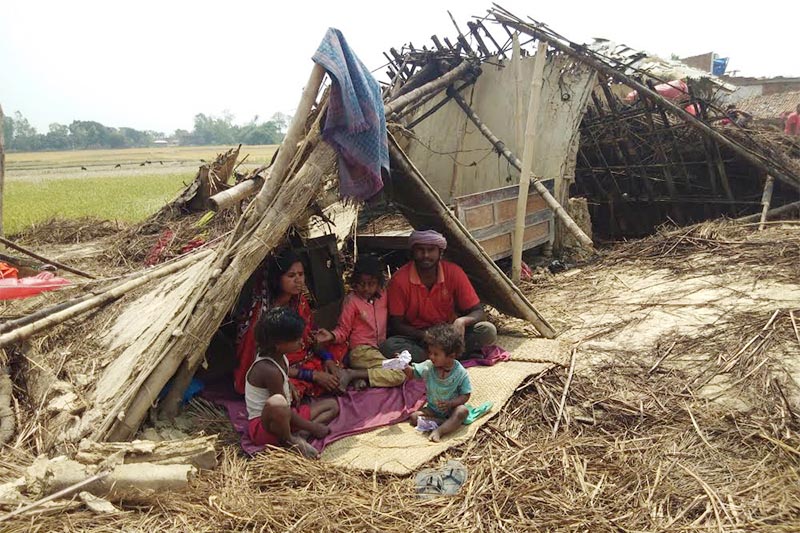Who should deliver tents, food to storm-hit?
Kathmandu, April 4
If you go by the government policy, disaster victims must receive humanitarian aid like tarpaulin tents, food and medical kit within 24 to 48 hours.
It has been four days since the deadly storm hit Bara and Parsa, which razed over 2,400 houses and rendered thousands homeless. But many are still spending nights under the sky with half-empty stomach.
Bara and Parsa are located in the plains and most of the places have access to roads. Yet many people in those areas still have not found food or tarpaulin tents to take shelter.
The Humanitarian Staging Area at Tribhuvan International Airport, where relief materials are stored by the government, has around 267 tents, 2,000 tarpaulin tents and 155 sleeping bags.
These materials are not adequate to meet the needs of latest disaster victims. But even these materials have not been transported to disaster-stricken areas due to lack of coordination between various bodies.
The federal government distributed 468 tarpaulin tents provided by Armed Police Force in Bara a day after the disaster. Today, 500 tarpaulin tents and 250 tents, stored in a warehouse of Province 3, were distributed in disaster-hit areas.
“What we have received so far is not adequate,” said Ameri Prasad Yadav, mayor of Pheta Rural Municipality, which was worst hit by the deadly storm that took lives of 28 people.
The rural municipality has also distributed 500 tarpaulin tents and 500 floor mats. It has also been providing food to disaster victims.
“But the supply has not been able to meet the demand. And we do not have adequate financial resources to cater to the needs of victims,” said Yadav.
The Disaster Management Division, under the Ministry of Home Affairs, is the central agency that should spring into action as soon as the disaster hits an area. Its main job is to coordinate with government agencies at central, provincial and local levels to supply necessary relief materials. But it is at a loss over what to do.
“Things have changed since the country shifted from unitary to federal system of government,” said Joint Secretary Indu Ghimire, head of the division. “Earlier, the district administration offices used to take charge as soon as the disaster hit an area. Now, these responsibilities have been transferred to local bodies. But local leaders are unaware of their duties. So, there is a lot of confusion.”
The Local Government Operation Act states that every local body must establish Disaster Management Fund, where five per cent of the budget provided by the central government must be parked. Local bodies should dip into this fund during disasters to provide humanitarian aid to victims.
“We have around Rs 2 million in the fund,” Sunil Prasad Yadav, chief administration officer of Pheta Rural Municipality, said. “We have been using this money to provide food to victims and buy tarpaulin tents and floor mats. But this money is not adequate to provide other humanitarian aid. So, provincial and central governments should step in.”
Provinces should also establish funds of this type. “But such a fund has not been formed in Province 2 (where Bara, the disaster-hit area, is located), as the bill required to establish it is in the provincial assembly,” said Jitendra Sonal, Province 2 Minister of Physical Infrastructure and Development.
Province 2 also does not have a warehouse where humanitarian aid, such as tarpaulin tents, corrugated zinc sheets, first aid kits and clothes, need to be stored.
“Ideally, the federal, provincial and local governments should have humanitarian aid sufficient for two per cent of the population in their warehouses. If we follow this simple practice, disaster victims will not have to spend nights under the sky or go hungry,” said Beda Nidhi Khanal, under-secretary at the National Emergency Operation Centre, which is under the Ministry of Home Affairs.
But before providing aid to victims, Initial Rapid Assessment must be conducted within 24 hours of the disaster, according to the National Disaster Response Framework 2011. This assessment is conducted by the NEOC in support of Red Cross Society, Nepal Police and the local government. This report provides data on number of victims, their whereabouts and conditions, and their needs. This assessment makes aid distribution seamless and helps in even distribution of aid. But even after four days of disaster, the NEOC has not made this report public.






